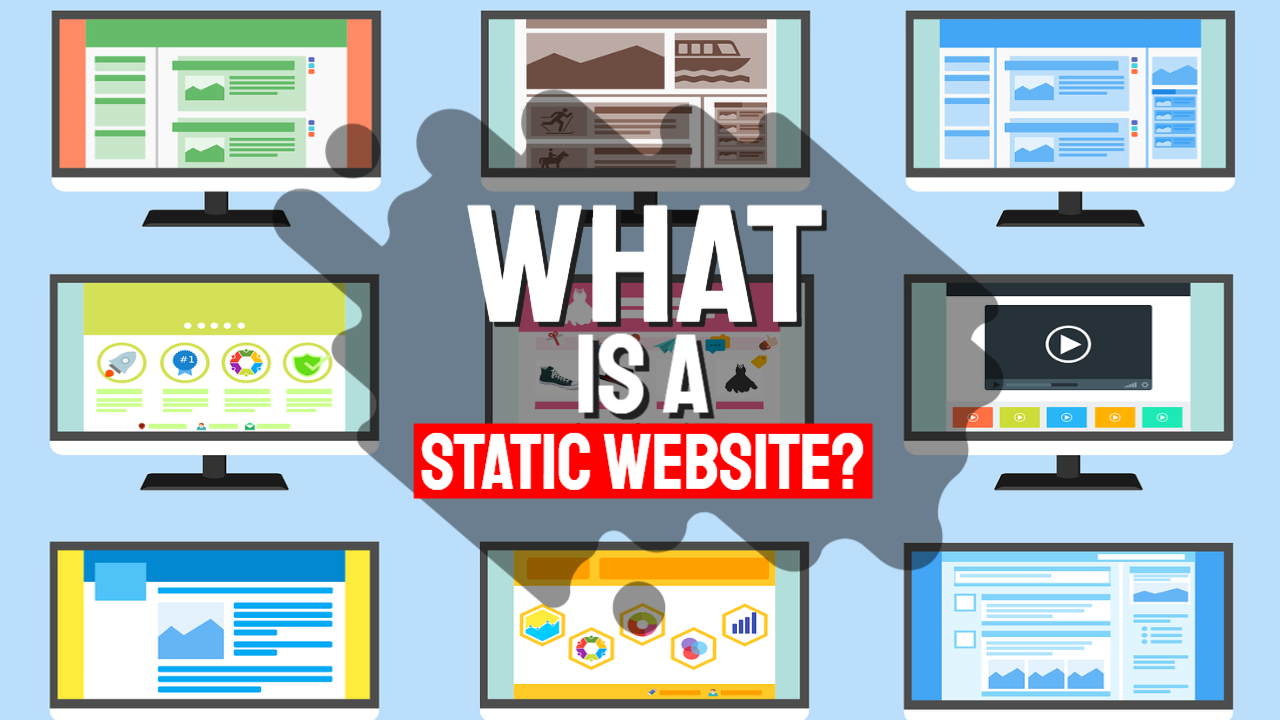The question of; “What is a Static Website?” is often asked, and is answered here, and that’s not all as we also spill the beans on just how you make a Static Web Page with an example.
Explore the Key Concepts Around Static Websites
- Understanding the Fundamentals of Static Web Pages
- Delving Into the Definition of Static When Rendering Websites
- Evaluating the Pros and Cons of Static Websites
- Insights on Dynamic Websites and Their Functionality
- Comparative Analysis of Static and Dynamic Websites
- How a Website Can Propel a New Business Forward
- Identifying Optimal Moments for Your Website Re-Design
- The Crucial Role of Quality Content in Website Development
- Static vs Dynamic Websites: Which Is Superior for SEO?
- Clarifying the Distinction Between Dynamic and Static Websites
Understanding the Fundamentals of Static Web Pages
A static web page (often referred to as a flat page or a stationary page) is one that is delivered to users' web browsers exactly as it is stored on the server. This contrasts with dynamic web pages, which are generated by web applications based on user interactions or other variables. Static web pages are designed to provide the same content to every visitor, regardless of their context, although modern server capabilities can adjust content type or language if configured to do so. This consistency makes static pages reliable for presenting information that doesn’t frequently change.
Typically, static web pages are created using HTML documents that are stored as files in a file system and served via HTTP. However, it’s important to note that URLs ending with “.html” do not always guarantee a static page. Additionally, broader interpretations of static pages could encompass those stored in databases or formatted using templates served through application servers, provided that the content remains unchanged and is presented as originally stored. Static web pages work best for content that is seldom updated, although advancements in web template systems are altering this landscape. Managing numerous static pages can be cumbersome without automation tools like static site generators, with platforms like GatsbyJS and GitHub facilitating the transition of WordPress sites into static web pages. Notably, any personalization or interactivity on such pages must execute client-side, which can limit functionality.
Delving Into the Definition of Static When Rendering Websites
Defining a Static Website
A static website comprises web pages with fixed content, meaning each page is coded in HTML and presents the same information to every visitor. Static sites represent the most fundamental type of website, making them the easiest and quickest to create. Unlike their dynamic counterparts, static websites do not necessitate any web programming or database design. A static site can be established simply by crafting a few HTML pages and publishing them to a web server, making it accessible to users online.
Since static web pages maintain fixed code, the content displayed remains unchanged unless manually updated by the website administrator. This design is effective for smaller websites, yet it presents challenges for larger sites comprising hundreds or even thousands of pages, where maintenance can become complex and labor-intensive.
Evaluating the Pros and Cons of Static Websites
Static websites possess several characteristics that define their operation. They exhibit fixed content, meaning that modifications can only occur through direct changes to the source code. When a user requests a static web page, the server delivers the page without altering the content, ensuring that the information presented is exactly what is embedded within the HTML code.
The benefits of a static website are numerous:
- Lower development costs.
- Enhanced ease of indexing by search engines.
- Simplified hosting requirements.
- Ideal for small or personal websites.
- Quicker loading times, especially on slower network connections.
Once a static website is created, its pages remain unchanged until updated through coding skills. This presents a challenge for business owners who may need to change specific information, as they will require a web developer's assistance for any alterations.
Time efficiency is one of the primary advantages of static websites; they can be developed much more swiftly than dynamic sites. For businesses on a tight budget, static websites offer a cost-effective solution. Additionally, static sites can secure dedicated hosting at a lower price, and their simple structure allows for inexpensive website hosting. The straightforward nature of static websites also aids in their indexing, making it easier for search engines like Google and Bing to index them as they consist of basic coded HTML or CSS files.
However, static webpages come with significant drawbacks. Updating or changing content on static sites can be expensive, especially if the website has a large number of pages. The costs associated with hosting and maintaining numerous static pages can escalate quickly. Furthermore, maintaining a static website can be labor-intensive and time-consuming, as site owners may need to rely on their knowledge of HTML and other programming languages to make necessary updates. Additionally, flexibility is a concern; for example, if a business aims to sell numerous products, individual pages must be created for each product, which can be a daunting task in terms of time, effort, and cost. Static site generators may also present challenges due to complex installation processes and a lack of user-friendly interfaces.
Despite these challenges, there are scenarios where a static site generator (SSG) may be more advantageous than a content management system (CMS), especially when the latter might be excessive for the project's needs.
Insights on Dynamic Websites and Their Functionality
Dynamic websites offer a more efficient solution for larger sites that feature numerous pages, news articles, or product listings. Unlike static sites, dynamic websites change or customize their content frequently and automatically. Server-side dynamic pages are generated in real-time by computer code, which dynamically produces the necessary HTML (while CSS files remain static and control the site's appearance).
Comparative Analysis of Static and Dynamic Websites
It is nearly impossible to discuss static websites without juxtaposing them against dynamic sites, especially given the prevalence of dynamic content. This comparison is essential to understanding the advantages of adopting a static methodology when developing your website.
Most websites utilize a blend of static and dynamic content; for instance, a dynamically generated search request can appear alongside static sidebars, headers, and footers. For the purpose of this discussion, however, we will focus primarily on websites that prioritize a “static first” approach.
How a Website Can Propel a New Business Forward
For new businesses, the ability to make simple adjustments to calls to action is invaluable. Hence, the focus should not be solely on the conversion rates of animated or static website banners but should encompass all aspects that can drive engagement and sales.
Identifying Optimal Moments for Your Website Re-Design
The traditional web design process can be quite labor-intensive and time-consuming. It often requires you to research the latest technologies and incorporate them into your website all at once, which can lead to missed opportunities as sections of your site may be inaccessible during the redesign phase.
Creating basic layouts and designing a new website demands significant time investment. Furthermore, testing web applications can be a tedious process, often fraught with potential errors. Basic decisions regarding web development typically rely on the developer's expertise, which can further delay the project.
However, it’s important to note that the design can remain consistent regardless of whether your site is dynamic or static. By streamlining the development process, businesses can allocate more resources toward enhancing the actual design of their website, fostering a more engaging user experience.
The Crucial Role of Quality Content in Website Development
For smaller websites, a fixed (static) website can suffice. However, any website aspiring to rank favorably against competitors must be built around high-quality, relevant content. The significance of maintaining strong, engaging content on a website cannot be overstated, as it plays a vital role in attracting and retaining visitors.
Static vs Dynamic Websites: Which Is Superior for SEO?
If a website isn’t regularly updated, it risks stagnation and eventual decline, which can severely impact its SEO performance. Various factors contribute to enhancing your site's usability, starting with the type of website itself. The distinction between static and dynamic sites can significantly influence user experience and search engine optimization outcomes.
We are confident that static websites will gain popularity in the future. In the meantime, it is remarkably easier to outperform a cumbersome dynamic site in terms of SEO using a static one; now is the ideal time to capitalize on this advantage! Unlike static websites, dynamic sites are built in real-time and are designed to be adaptive. Dynamic websites facilitate targeting multiple keywords for SEO, allowing operators to swiftly adjust their list of target keywords to achieve desired search engine results.
Clarifying the Distinction Between Dynamic and Static Websites
Tools like Gatsby convert markdown and other static data sources into dynamic blogs and websites utilizing ReactJS. By embracing the component-driven development model of React, Gatsby ensures consistency and speed by reusing components throughout the site. While larger websites necessitate frequent updates, making a CMS a suitable choice, there exists a plethora of static websites on the internet. Identifying static versus dynamic websites is a straightforward task.
Budgeting for developers to address bugs during the development phase is crucial; this aspect should be prioritized to determine an appropriate solution that fits within your financial constraints, given that dynamic websites typically incur higher costs than static ones. Are you still following along? I hope I haven’t lost your attention. In essence, every website you encounter in your browser is static. Yet, a significant portion of the online landscape consists of so-called “dynamic” websites. Our observations align with our experiments, reinforcing this perspective. Dynamic websites often suffer from excessive scripts and bloated code. While the optimized version of the NYT we analyzed is not a static website, it provides insight into what a streamlined and efficient NYT website could resemble.
This is where dynamic website design comes into play. Both static and dynamic web design have their respective advantages and disadvantages, yet dynamic web design frequently emerges as the superior option. Below, we provide a comprehensive overview of dynamic web design: what it is, how it contrasts with static web design, and why it represents a valuable investment.
The post What is a Static Website? and How to Make a Static Web Page With an Example appeared first on GQ Central.



Comments are closed